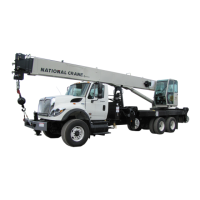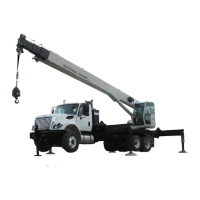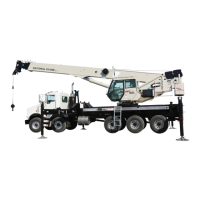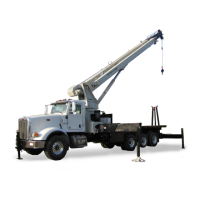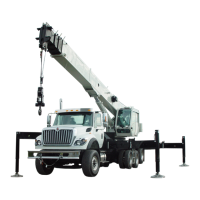Published 3-30-2018, CTRL 636-05 2-29
CD15 OPERATOR MANUAL SAFETY INFORMATION
• Any kinking, bird caging, crushing, corrosion, or other
damage resulting in distortion of the rope structure.
• Rope that has been in contact with a live power line or
has been used as a ground in an electric circuit (eg.
welding) may have wires that are fused or annealed and
must be removed from service.
• In standing ropes, more than three (3) breaks in one
rope lay in sections beyond the end connection or more
than two (2) broken wires at an end connection.
• Core deterioration, usually observed as a rapid
reduction in rope diameter, is cause for immediate
removal of the rope.
The following is a brief outline of the basic information
required to safely use wire rope.
• Wire ropes wear out. The strength of a rope begins to
decrease when the rope is put to use and continues to
decrease with each use. Rope will fail if worn-out,
overloaded, misused, damaged or improperly
maintained.
• The nominal strength, sometimes called catalog
strength, of a wire rope applies only to a new, unused
rope.
• The nominal strength of a rope should be considered the
straight line pull which will actually break a new unused
rope. The nominal strength of a rope should never be
used as its working load.
• Each type of fitting attached to a rope has a specific
efficiency rating which can reduce the working load of
the rope assembly or rope system.
• If an operator hoists the hook block up or down too fast
when reeved with multiple parts of line and no hook load,
the wire rope can bird cage and damage the rope.
• Never overload a rope. This means never use the rope
where the load applied to it is greater than the working
load determined by the rope manufacturer.
• Never “shock load” a rope. A sudden application of force
or load can cause both visible external and internal
damage. There is no practical way to estimate the force
applied by shock loading a rope. The sudden release of
a load can also damage a rope.
• Lubricant is applied to the wires and strands of a wire
rope when it is manufactured. The lubricant is depleted
when the rope is in service and should be replaced
periodically. Refer to the Service Manual for more
information.
• In the U.S.A., regular inspections of the rope and
keeping of permanent records signed by a qualified
person are required by OSHA for almost every wire rope
application. The purpose of the inspection is to
determine whether or not a rope may continue to be
safely used on the application. Inspection criteria,
including number and location of broken wires, wear and
elongation, have been established by OSHA, ANSI,
ASME and similar organizations. See the Service
Manual for inspection procedures.
When inspecting ropes and attachments, keep all parts
of your body and clothing away from rotating hoist drums
and all rotating sheaves. Never handle the rope with
bare hands.
Some conditions that lead to problems in wire rope
systems include:
- Sheaves that are too small, worn or corrugated
cause damage to a wire rope.
- Broken wires mean a loss in strength.
- Kinks permanently damage a rope and must be
avoided.
- Ropes are damaged by knots. Rope with knots must
never be used.
- Environmental factors such as corrosive conditions
and heat can damage a wire rope.
- Lack of lubrication can significantly shorten the
useful life of a wire rope.
- Contact with electrical wires and resulting arcing will
damage a wire rope.
• An inspection should include verification that none of the
specified removal criteria for this usage are met by
checking for such things as:
- Surface wear; nominal and unusual.
-
Broken wires; number and location.
- Reduction in diameter.
- Rope stretch (elongation).
- Integrity of end attachments.
- Evidence of abuse or contact with another object.
- Heat damage.
- Corrosion.
NOTE: A more detailed rope inspection procedure is given
in the Service Manual.
• When a rope has been removed from service because it
is no longer suitable for use, it must not be reused on
another application.
When installing a new rope:
• Keep all parts of your body and clothing away from
rotating hoist drums and all rotating sheaves.
• Never handle the wire rope with bare hands.
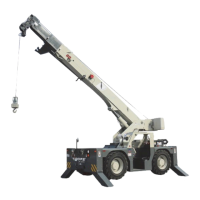
